These days, most DAWs come with a host of built-in free VST plugins. These are generally designed to provide you with a solid set of starting tools to make the most of your DAW. However, most DAW designers excel at building DAWs and not as much at creating VSTs. While there are always a few standout tools that every DAW user couldn’t live without, it’s quite common to find a large array of third-party plugins in professional studios. I know from experience that over 95% of the plugins I use on a regular basis are third-party.
Now I’m sure you’re thinking that it’s all well and good to have third-party VSTs if you have the money. This is where I step in. Today we’re going to take a look at 13 free VST plugins for Windows that give high-end gear a serious run for their money.
Table of Contents
- Free VST Reverbs
- Time for Some EQ
- The Best Free Compressor VSTs
- Moving on to Mastering Tools
- A Great Set of Free VST Plugins for Beginners
- A Few Additional Mentions in the Free VST World
- TL;DR
Free VST Reverbs
First off, let’s take a look at reverbs. This is probably one of the most abundant types of freeware plugins on the market. However, there are some real duds out there. I’ve got two great pieces of software here that will really help bring some depth to your mixes.
epicVerb by Variety of Sound
The first of these is epicVerb. Designed for maximum flexibility, this algorithmic reverb does it all. From small, ambient spaces to luscious halls, you’ve got full control. With built-in EQ and modulation controls, there aren’t many spaces you can’t recreate with this plugin.

RoomMachine 844 by Silverspike
Another interesting reverb plugin is RoomMachine 844. This plugin appears to be modeled on a convolution premise in that it is designed to simulate speakers and microphones in a real space. However, since they are digital, we can assume it is still using algorithms for the calculations and not impulse responses. Nonetheless, it still has a unique premise. You can use the positions section to place virtual loudspeakers and dictate their stereo width and distance from the microphones. This lets you simulate real spaces that suit what you are trying to achieve. The controls are simple, and while you certainly won’t get as many unique tones out of this one, it’s still a fantastic free VST.

Time for Some EQ
There are a variety of different EQ types out there, and every DAW comes with at least one. This is typically a standard parametric EQ with fairly limited capabilities. As such, I can imagine that you might want a few more choices when using EQ.
Luftikus By IJKB
Some of my favorite EQs to work with are also some of the simplest ones available. I’ve always loved mixing with hardware EQ and really using my ears to sculpt the tone of my signals. As such, fixed-band EQs, while limiting, give me fantastic results. Unlike parametric EQs, you have to work with the fixed bands and, as such, be far more careful with your choices. Using your ears, you make minor adjustments and keep things musical, not clinical.
Now, unfortunately, these types of EQs usually come at a cost. They are typically emulations of famous hardware and, as such, yield similar prices. I’m talking about things like APIs and Pultecs. That was until I came across Luftikus.

This multi-band fixed EQ comes with four half-octave bells, one half-octave high shelf, and another high shelf with adjustable fixed frequency points. It’s generally very gentle, and you’ll have to really crank the knobs to get it to do much. However, this is kind of what makes it great. It’s one of those tools that’s handy when you’re trying to be subtle, especially with subtractive EQ. Bus EQing and master channel EQing come to mind here.
It also has three switches built into the bottom. One enables ‘mastering’ mode, which changes the EQ knobs from being adjustable by 0.1dB to being adjustable by 1dB. This means that each step on the knob will have a significantly more noticeable effect as it jumps. Very handy for final adjustments and mastering. We’ve also got an ‘analogue’ switch to emulate an analogue sound. Finally, there is a ‘keep gain’ switch designed to adjust the overall level of the signal as you make changes. This is really handy when you need to A/B the plugin.
Electri-Q (Posihfopit Edition) By Aixcoustic Creations
Now, if you’re more in the market for control over your EQ, you might like what I have next. [Electri-Q (posihfopit edition) is is a powerful, low phase parametric EQ with the capability to handle up to 64 bands. It also comes with a variety of filter types and the ability to switch between clean digital EQ and transformer modelled analogue EQ that’s a touch more colourful.
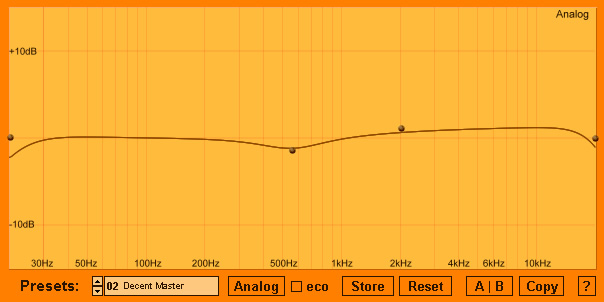
While most DAWs typically offer their own parametric EQ, this one gives you a little bit more. With its added controls, expanded band allowance, and low-phase calculations, it becomes a powerful tool for mixing and mastering. It’s not the prettiest of things to look at, but then who really cares?
The Best Free Compressor VSTs
Compression is always a tricky one for beginners. Just like with EQ, most DAWs only come with one standard compressor that often has a one glove fits approachall approach. For anyone who understands compression, you’ll know that no single compressor is perfect for everything. Below are a couple of really great tools that I guarantee will perform far better than any built-in DAW compressor.
MJUC JR by Klanghelm
In a previous article, I addressed the different circuit types that you can typically find in compressors. One of the lesser-known types is the Vari-Mu. Often used in mastering, Vari-Mu (or variable-gain) is a tube-based compression type. The original design is owned and trademarked by Manley and costs so much that you’d need to remortgage your studio. However, there are plenty of software alternatives out there. Obviously, these don’t use tubes, so you’re not going to get that true vari-mu sound. However, the concept for the compression type holds true, and there are even free versions on the market.
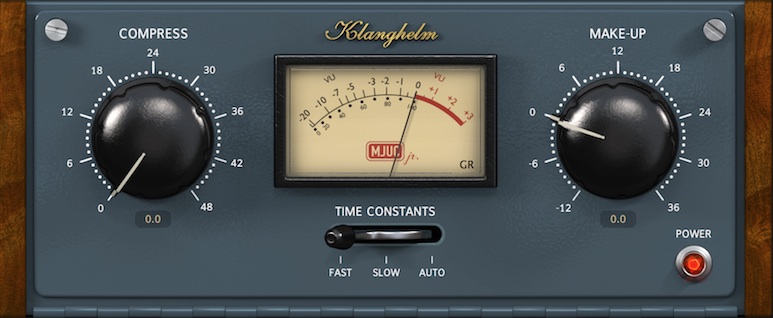
The MJUC JR by is Klanghelm is a great example of this. It has a simple and straightforward design, just like a vari-mu should. We get one knob for the amount of compression and another for makeup gain. We also have a control for the recovery time and slew rate, giving us control over different content types. Stacked up against the Waves Puigchild, this plugin performs pretty well. It works great as a glue compressor; however, I find it a little over-aggressive for the circuit type.
Molot By Vladg/Sound
Another great compression plugin to have on hand is Molot. On the surface, this looks like a fairly typical optical compressor. However, once you apply it to a channel, it really comes into its own. This plugin is far from transparent and offers a staggering amount of power. You’ve got the addition of a high-pass filter, as well as a limiter, mid-scoop bell EQ, and multiple stereo image modes. For me, this is reminiscent of the Fairchild in its design but more like an 1176 in its sound. It’s something you’ll probably have to learn to use and then only implement when you know you need it. But when you need it, it works wonders!
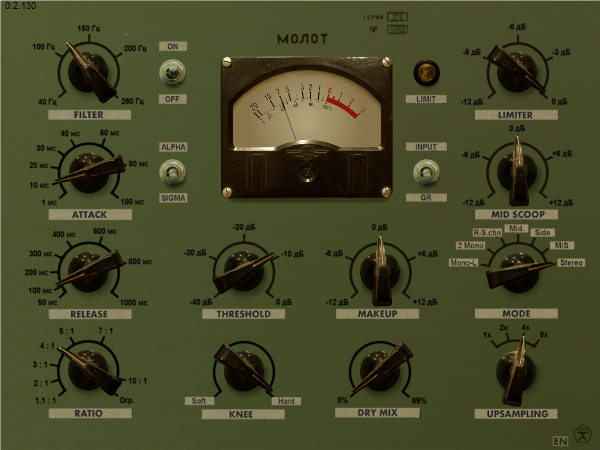
Having a variety of compressors in your arsenal is imperative. Knowing how and when to use them is even more important. Many DAWs come with one stock ‘one glove fits all’ compressor, which is really no help. Grab these great free VST plugins to ensure you’ve got choices in your toolkit.
Moving on to Mastering Tools
Besides the typical tools such as EQ and compression, mastering tends to deal with the subjects of width and loudness. Here are a few freebies that can help get your tracks into that commercial realm without costing you a penny.
YouLean Loudness Meter
Being able to measure loudness and dynamic range accurately is one of the most important things a mastering engineer has to do. You can easily pay hundreds on histogram tools with fully customizable features. Or, you can grab the [Youlean Loudness Meter for for absolutely nothing.
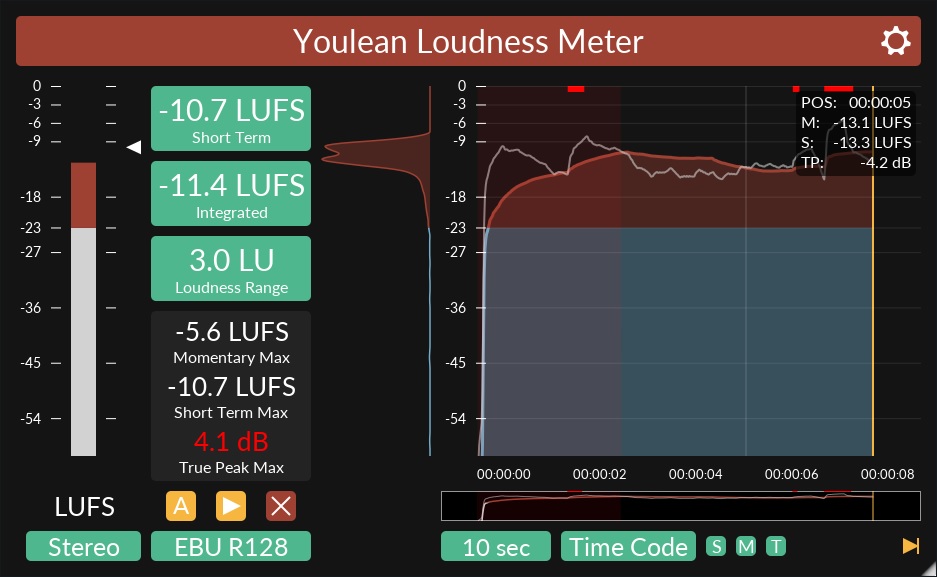
A truly marvelous tool that does everything you need a LUFS loudness meter to do. It provides easy-to-understand short-term and integrated loudness metering with a dynamic range readout and a true peak detector. It also provides measurements in mono and stereo and has a detailed and adjustable histogram. Seriously, you couldn’t ask for much more from something like this, especially when it’s completely free.
If you don’t already have some form of loudness metering software, this is a great place to start. I routinely place this on my master channel even when I’m doing production or mixing work. It’s a really easy way to make sure you’re not clipping and a fabulous tool for identifying dynamic contrast in your work. Equally, it’s very handy when it comes to examining reference tracks. If you’re aiming for commercial loudness and want to be competitive in the market, this plugin will set your mind at ease in a heartbeat.
TT Dynamic Range Meter
Another great little tool to grab is the [TT Dynamic Range Meter. Far Far simpler than the loudness meter above but it does a great job at measuring dynamic range and peak levels. For a low CPU quick mix checker, it’s definitely worth having. Especially before sending your material off for mastering.
Ozone Imager by Izotope
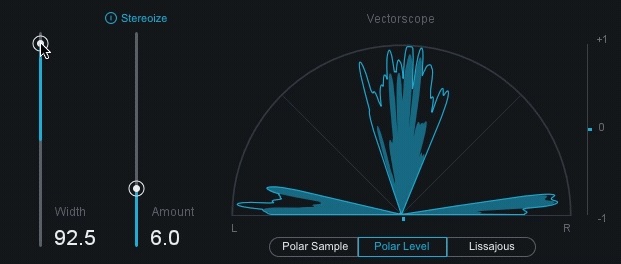
Another notable mention for freebies is the Ozone Imager. A slightly simpler version of the one that comes with the paid suite, this little gem is a great mastering tool for stereo width. It’s not something that I’m a huge advocate of because of the phase issues that these tools can cause. However, when used subtly for a little bit of separation, it can yield great results. It has a beautiful, simple design with a fader for width and another for the amount of stereoization. The vectorscope is a lovely feature and helps to show you exactly what’s going on under the hood. Grab this while it’s available for free and get to work on widening your mixes. Just remember to check the mono mix afterward!
A Great Set of Free VST Plugins for Beginners
Now this tenth plugin is a little more than just a single tool. As I mentioned earlier, many DAWs come with plenty of built-in tools. However, sometimes they are a little lacking, or you might be missing a few of the essentials. If this sounds like the problem you’re facing, I suggest you check out Dead Duck Software.
With a plain but appealing GUI, Dead Duck provides 24 free VST plugins for all your production and mixing needs. From a full channel strip to a ring modulator, this plugin bundle encompasses a really great set of tools. You’ve probably got alternatives for many of them already, but where you don’t, they make a really strong addition. The simple design makes them great for beginners, and they won’t let you down in terms of functionality.
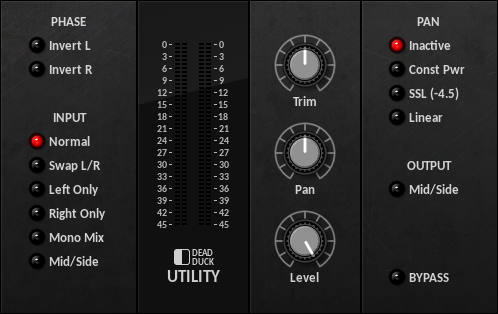
Even if you think you’ve got all the basic tools already, there is one standout here: the Utility plugin. This is something that now lives on my master bus by default. Being able to quickly switch between your stereo, mono, and mid/side mix is super helpful. Additionally, it’s great for checking out the separate sides of your mix independently as well as their phase. Do yourself a favor and experiment with some of these. I’m certain you’ll find something worth keeping in your toolbox.
A Few Additional Mentions in the Free VST World
Among the typical tools listed above, there are also a variety of specialist tools that can come in handy in certain situations. The ones I’ve sourced below for you are particularly useful because they aren’t commonly available in the typical DAW.
Vinyl by Izotope
The first of these is a plugin called Vinyl. Known as “The Ultimate Lo-fi Weapon,” Vinyl is a multi-parameter plugin designed to simulate the grit and noise of old analogue formats. This is one of those plugins that you can strap onto your master channel and use to dial in a bit of noise and ambience. It’s designed to give your tracks a little bit of character and edge. Now, this won’t be for everyone. I know plenty of people love a clean, modern sound and are thankful that gear has moved on from the noisy old bits of kit we had to use before. However, if you’re all about a touch of retro and lo-fidelity, then you are going to love this free plugin.
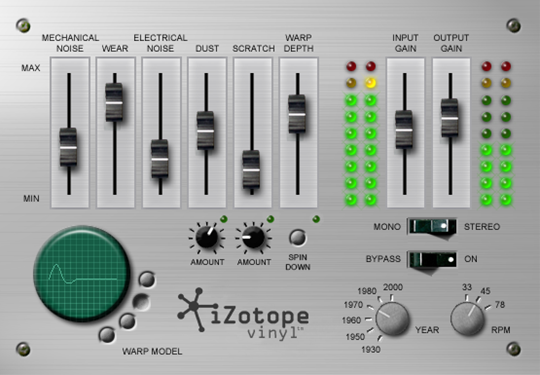
You’ve got controls for mechanical noise, electrical noise, dust, scratch, and warp. Not only this, but you can dial in the amounts of each that you want, as well as adjusting the whole plugin to replicate a different part of history. From the 1930s to the 2000s, Vinyl can emulate an incredibly authentic sound for any genre at its high point. This is going to be especially great for those of you looking to achieve a really gritty 90s sound.
Bark of Dog by Boz Digital Labs
One of the most common things I find I have to do when mixing and mastering my client’s works is dealing with the low end. I’m often met with comments like “the tracking went well but we couldn’t get much low end from the kick“. Learning to position microphones and get the sound you want is a skill in itself. As much as it’s good to get it right at the time, some things can be improved in the mixing stage. Enter bass enhancement plugins.
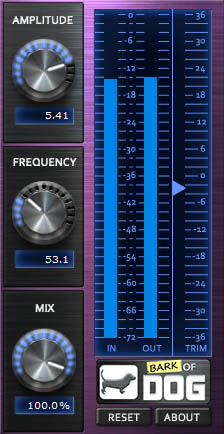
As a big fan of Waves, I’ve always opted for using things like Renaissance bass for my low-end reinforcement. However, I was recently let on to a free VST plugin by the name of [Bark of Dog that that does the exact same thing that my Waves plugin can do. Naturally, I was curious to see whether a free plugin could keep up with the likes of Waves.
While the GUI isn’t as aesthetically pleasing, the plugins actually have an almost identical setup: frequency selection, input gain, and output gain. Where the Bark of plugin Dog plugin has an edge is that it also allows you to control the wet/dry mix of the plugin. I see this as fairly redundant, as I typically just dial in the amount of gain I want. If I need less, I’ll dial in less rather than varying the wet/dry. However, it’s still an extra feature that Waves doesn’t provide.
In use, these plugins perform at an exceptionally similar level. There are very minute tonal differences between the two, but I found that the Waves plugin was slightly better at handling sonically dense tracks. However, for a free plugin, Bark of is Dog is 100% worth downloading if you’re working on a budget. Try it out on full mixes and on individual channels, and I think you’ll be pleasantly surprised at what it can do.
CamelCrusher by Camelaudio
For those of us mixing in the box, distortion and saturation plugins have always been a tricky area. If you’re lucky enough to have some decent outboard gear, then you’re probably fine. Unfortunately, those of us working in the digital realm haven’t had as many options. This is even truer when it comes to free VST plugins. However, there is one that has always served me well in a pinch: CamelCrusher. It not only offers fantastic distortion tones but also comes with a handy filter and compressor section to help you sculpt the results.
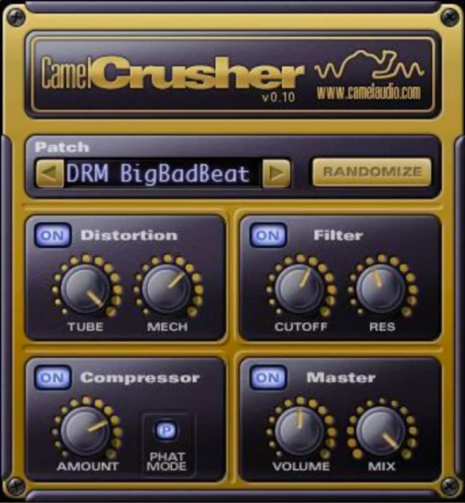
Offering tube distortion as well as mechanical distortion, CamelCrusher gives you multiple tone options at no cost. The low-pass filter isn’t anything special, but it’s another great way to control your distortion without the need for additional plugins. Again, the compressor is pretty simple and applies some soft limiting to smooth out the dynamic range. The “phat mode” button essentially applies smoother results. I find that it seems to almost always work better when turned on. I wouldn’t use this compressor as a first choice, but it’s a handy little tool for smoothing out the effects of the distortion if it’s a bit too aggressive.
TL;DR
There is a multitude of free VST plugins out there that are truly worth having. Moreover, some of them can honestly compete with big names like Waves and Slate. This list doesn’t encompass everything available, but it’s a good place to start. To summarize, we’ve got: epicVerb and RoomMachine 844 reverbs; Luftikus fixed EQ and Electri-Q low-phase parametric EQ; Klanghelm’s MJUC JR vari-mu compressor and Vladg’s Molot; The Youlean Loudness Meter, TT Dynamic Range Meter, and Izotope’s Ozone Imager; the entire Dead Duck VST package; and Izotope Vinyl, Bark of Dog, and CamelCrusher. So, what are you waiting for? Go download these plugins and start experimenting!
À propos de l'auteur

Tim Dunphy
Ingénieur audio et rédacteur de contenu spécialiséPlus de 10 ans d'expérience dans le domaine de l'audio. Tout, de l'enroulement de XLR au mastering d'albums. Je suis un self-made-man et je garde mes actifs en bitcoins. Qu'y a-t-il de plus à savoir ?
Commentaires
Entra en la página del plugin que quieres descargar
como hago para obtener esos plugins
The links are in the article, there’s one separated link for each VST, that points to the source download page.
wHERE iS tHE lINK?
Laisse un commentaire
Connecte-toi pour commenter.


